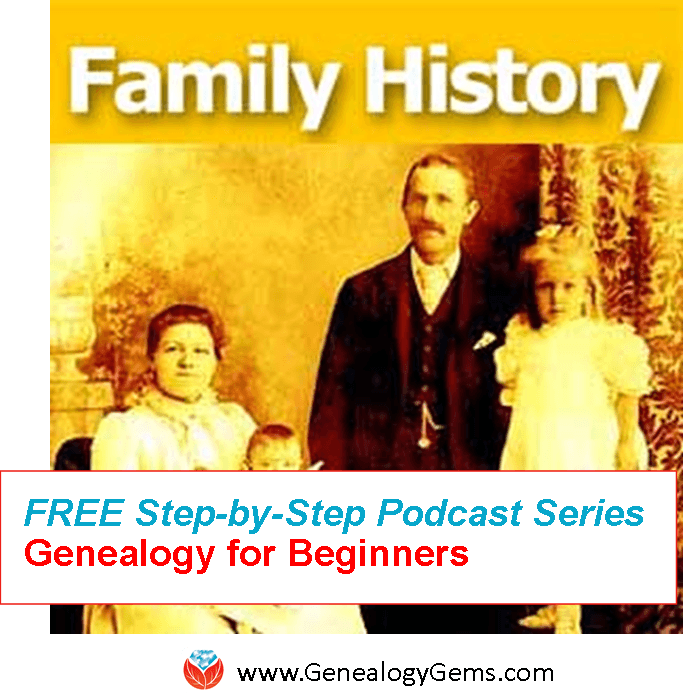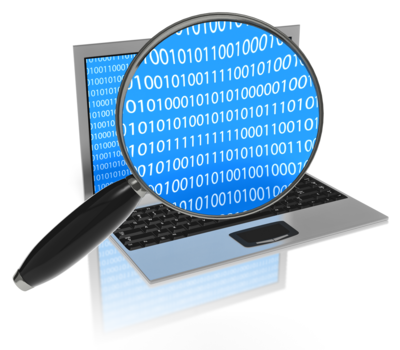by Lisa Cooke | Mar 15, 2014 | 01 What's New, Beginner, Organization, Source Citation
 I recently heard from a NEW podcast listener named Judie. As a beginning genealogist she excitedly dove into family history awhile back. However, she soon became overwhelmed by boxes full of uncited, unorganized information having made the biggest mistake beginning genealogists tend to make. Read her story below. Does this sound familiar? Then my answer to her may help you, too, whether you are a beginning genealogist or you need start over with a few things.
I recently heard from a NEW podcast listener named Judie. As a beginning genealogist she excitedly dove into family history awhile back. However, she soon became overwhelmed by boxes full of uncited, unorganized information having made the biggest mistake beginning genealogists tend to make. Read her story below. Does this sound familiar? Then my answer to her may help you, too, whether you are a beginning genealogist or you need start over with a few things.
A Beginning Genealogist’s Confession:
Dear Lisa,
“Just found The Genealogy Gems Podcast and love it. I started my family tree research several years ago by joining Ancestry.com. My tree grew quickly with all the information there but after a couple of years of making every mistake possible including merging everyone’s tree with mine, I ended up with thousands of names without documentation. Another mistake was visiting a couple of historical societies and libraries where I printed lots of information but failed to note where it came from. Ok, I’m sure you got the picture.
After a couple of years of doing everything wrong, and several “dead ends” I became so overwhelmed with so many names and unorganized papers that I packed everything in boxes that would most likely end up in a dumpster when I’m gone (sad but true). That was a year ago. After discovering your site I am ready to get back into the search but don’t really know where to begin. Do I ignore all that has been done and start over or is it possible salvage some of what I have? Do you have any suggestions – Thanks, Judie
My Fix It Advice for the Beginning Genealogist
Start fresh. Get yourself a good genealogy database on your computer and start with a more methodical process like I talk about in the step-by-step series Family History Podcast (Episode 1 is on databases) as well as the Genealogy Gems Podcast. Not sure which database to use? I blogged about that here.
Organize. Once you have a good set of habits, have made some progress, and feel comfortable with your database and citing your sources, then you can start dipping back into the box and “processing” each piece of paper.
If it were me I would toss all those merged trees. The stuff from the historical societies and libraries may be valuable, but without documentation, will have limitations. I would only keep the most obviously applicable items, and toss the rest or at least file it away for now. If you stay focused on all that paper it will direct you, rather than you directing the research process. It may cause you to get off track and lose valuable time.
As you review the “keeper” items and deem them worthy of adding data to your database, you will need to make note that the source is unknown. Use the info gleaned as clues, but realize you’ll still need primary documented sources to back it up.
Cite your sources from this point forward. Beginning genealogists often feel like citing their sources is boring and tedious, and can find it hard to see the long term benefits. Believe me, benefits abound and this is one of the most important things you can do for the health of your family tree! Benefits include:
- avoiding going after the same record twice
- creating a bread crumb trail that helps you retrace your steps
- A foundation for future generations to confidently build upon your research
- adding authority to your research and helping you defend it when challenged
Get a quick start with Elizabeth Shown Mills’ Quicksheet Citing Online Historical Resources.  For a more in depth studying of source citation turn to Mill’s book Evidence Explained:Citing History Sources from Artifacts to Cyberspace 2nd Edition
For a more in depth studying of source citation turn to Mill’s book Evidence Explained:Citing History Sources from Artifacts to Cyberspace 2nd Edition .
.
Bottom line: Put yourself in charge by following a logical research process. Don’t worry about time or paper having been wasted. The point is you jumped in and gave it a shot, and that’s a good thing. I’m just glad you’ve found Genealogy Gems and I’ve got lots of advice and info on the site, podcasts and videos to help you be successful.
Here’s to success!
Lisa
by Lisa Cooke | Mar 13, 2014 | 01 What's New, British, Inspiration, Irish, Military

Tyne Cot Cemetery. Photo by Sgt Jez Doak, RAF/MOD, via Wikimedia Commons at http://upload.wikimedia.org/wikipedia/commons/7/74/War_Graves_at_Tyne_Cot_Cemetary%2C_Belgium_MOD_45156481.jpg
The Press (York, UK) recently reported a story about 10 brothers who all enlisted to fight in World War I and the hubbub that followed.
“The family became minor celebrities because of the brothers’ service, and their story was used as a recruitment tool as the war went on,” reports the Press. Fortunately, most of these Irish immigrant boys came home alive. The story reports the recent discovery of one of their graves.
Have you ever found something like this in your family–stories of extraordinary sacrifice made during wartime? Tell us about it on the Genealogy Gems Facebook page!
by Lisa Cooke | Mar 11, 2014 | Family History Podcast, Genealogy TV, Who Do You Think You Are?

Listen to the Family History: Genealogy Made Easy podcast by Lisa Louise Cooke. It’s a great series for learning the research ropes and well as refreshing your skills.
Originally published 2009. Republished March 11, 2014
[display_podcast]
Download the Show Notes for this Episode
Welcome to this step-by-step series for beginning genealogists—and more experienced ones who want to brush up or learn something new. I first ran this series in 2008-2009. So many people have asked about it, I’m bringing it back in weekly segments.
Episode 22: Legend Seekers: A Genealogy TV Classic
Did you ever catch the PBS documentary Legend Seekers? It aired in 2009 and is now classic genealogy TV. Executive producer Ken Marks joins us on this episode of the podcast. He talks about the unique approach of this show for its time: the family history stories he brought to life were from everyday folks (not movie stars or rock stars) who have some very extraordinary stories in their family tree. Ken talks about the Lively Family Massacre in Illinois, which he recreates in the show, and how he went about helping the TV execs understand the mass appeal of the show.
Then Ken talks about the genealogical serendipity that he has his crew found themselves tapping into throughout the production. That’s something we can all relate to! So sit back and enjoy this sneak peek behind the scenes of a genealogy television classic.
Updates and Links
Legend Seekers: The Legend of the Lively Family Massacre was meant to be a pilot in a new series. The series didn’t pan out but the show was nominated for a regional Emmy award in the documentary category, received two Telly Awards (2008) and the Award of Superior Achievement from the Illinois State Historical Society, according to a press release posted at Eastman’s Online Genealogy Newsletter. Click here to watch Legend Seekers: The Legend of the Lively Family Massacre.
Other genealogy TV shows you might enjoy:
Finding Your Roots with Henry Louis Gates, Jr.
Genealogy Roadshow (stream episodes here)
Who Do You Think You Are?
by Lisa Cooke | Mar 8, 2014 | 01 What's New, Inspiration
 Everyone’s families have a little bit of mystery in their past–or a lot!
Everyone’s families have a little bit of mystery in their past–or a lot!
TheBlaze.com recently posted this great story about a woman who was able to solve a longtime family history mystery by posting it online at Metafilter.com, a crowd-source blog. She posted this query:
“In my grandmother’s final days battling brain cancer, she became unable to speak and she filled dozens of index cards with random letters of the alphabet. I’m beginning to think that they are the first letters in the words of song lyrics, and would love to know what song this was. This is a crazy long shot, but I’ve seen Mefites [other site users] pull off some pretty impressive code-breaking before!” Then she posted the “code” from one of the cards.
Within 15 minutes someone solved part of the puzzle: a section of the code was the first letters of the prayer from the New Testament, “Our Father who art in heaven, hallowed be thy name….”
Have YOU ever been faced with indecipherable notes left behind by a family member? What family history mystery do you wish an online community could help you solve? Share this on the Genealogy Gems Facebook page and leave your answers.
by Lisa Cooke | Mar 7, 2014 | Beginner, Organization, RootsMagic, Technology, Trees
 Just about every major genealogy website these days lets you build your family tree from scratch right on their website. But you may wonder what will happen to millions of carefully-constructed trees if the company goes out of business or the site goes down.
Just about every major genealogy website these days lets you build your family tree from scratch right on their website. But you may wonder what will happen to millions of carefully-constructed trees if the company goes out of business or the site goes down.
Before the days of internet genealogy, researchers organized family history findings on their home computers in specially-designed software. These programs generated .GED files (called GEDCOMs), a universal file type that allowed researchers using different software to share their findings. Software like this still exists. These days it can communicate your research to any genealogy sites you care to share with–by using those same GEDCOM files.
If you do choose to build your family tree online, make sure you can download your tree anytime as a GED file. Keep this file as a backup both on your computer and in a second location (like cloud storage). But my recommendation is to build your tree at home, in your own software. Then you can upload or synch your data to your favorite genealogy websites whenever you want–and you never lose control of your research.
Choosing the Right Software
There are lots of family history programs out there, and all of them will serve your basic needs. But you only need ONE. What’s the best genealogy software? It depends on how much you want to spend and how sophisticated you want your database to be. In many cases, you can order the product or purchase a digital download. I really don’t think you need the physical boxed product. All the help you need is online. All of these products offer a free demo that you can download to try it out before you buy.
FREE AND EASY: Family Tree Builder by MyHeritage helps you stay organized with streamlined screens to work in and doesn’t require a lot of startup time. Family Tree Builder offers lots of family history charts; custom reports; helps you share your data and pictures on a CD or DVD; allows you to back up your files to CD or DVD; and includes genealogy apps for mobile devices. Download the software FREE at the above link.
PC (and NOW MAC) OPTION WITH GREAT REPORTS: If you’re looking for great printed reports that you can share, and loads of free online help videos, then RootsMagic is a great choice. (and we are honored to have RootsMagic as a sponsor of The Genealogy Gems Podcast.) And they now have an iOS app.
Some of the differences you’ll find between these products is the types of reports and charts they produce. So if that’s important to you, you can try the demos and see which you like. But again, I really don’t think you can go wrong with any of these products. They are all well established and supported. (Update: There have been many updates since the post was first published, including a Mac version. Click here for a series of article by date on RootsMagic updates and their app.)
POPULAR PC AND APP PROGRAM: Legacy Family Tree is also an extremely popular program and solid choice. To give it a test run, download the free version. Then check out its strength in regards to source citations: you can now record the quality (original vs derivative, primary vs secondary, etc., direct vs indirect) of each source as you work on proving your conclusions. And they have an app called Families for your mobile device. Learn more about the app here.
AFFORDABLE MAC OPTION: iFamily for Leopard is the most affordable at $29.95. There’s a free demo you can try before you buy.
TOP-SHELF MAC OPTION: Reunion 11 by Leister Pro is fairly pricey at $99.00. We’ve featured Reunion in the past: listen to Episode 51 of The Genealogy Gems Podcast. In that episode you can listen to a review of Reunion 9 by Ben Sayer, the MacGenealogist. And if you want to compare iFamily against Reunion to see what you’re getting for your money, you can also listen to Ben’s review of iFamily in Genealogy Gems episode 53.
 I recently heard from a NEW podcast listener named Judie. As a beginning genealogist she excitedly dove into family history awhile back. However, she soon became overwhelmed by boxes full of uncited, unorganized information having made the biggest mistake beginning genealogists tend to make. Read her story below. Does this sound familiar? Then my answer to her may help you, too, whether you are a beginning genealogist or you need start over with a few things.
I recently heard from a NEW podcast listener named Judie. As a beginning genealogist she excitedly dove into family history awhile back. However, she soon became overwhelmed by boxes full of uncited, unorganized information having made the biggest mistake beginning genealogists tend to make. Read her story below. Does this sound familiar? Then my answer to her may help you, too, whether you are a beginning genealogist or you need start over with a few things. For a more in depth studying of source citation turn to Mill’s book Evidence Explained:Citing History Sources from Artifacts to Cyberspace 2nd Edition
.




 Just about every major genealogy website these days lets you build your family tree from scratch right on their website. But you may wonder what will happen to millions of carefully-constructed trees if the company goes out of business or the site goes down.
Just about every major genealogy website these days lets you build your family tree from scratch right on their website. But you may wonder what will happen to millions of carefully-constructed trees if the company goes out of business or the site goes down.


